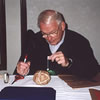Our neighbor, the Andromeda spiral galaxy.
Click on image for full size
Image provided by Jason Ware
Spiral Galaxies
Spiral galaxies may remind you of a pinwheel. They are rotating disks
of mostly hydrogen gas, dust and stars. Through a telescope or
binoculars, the bright nucleus of the galaxy may be visible but the
spiral arms are dimmer and difficult to see.
Spiral galaxies are complex objects and have several components: a
disk, a bulge, and a halo. The disk contains gas, dust, and young
stars in its spiral arms. The dense bulge in the center of the disk
contains mostly old stars and no gas or dust. The halo is the home of
a very few, scattered stars and globular clusters. The halo
is also the home of dark
matter in spiral galaxies.
Spirals are subdivided based on the appearance of the arms and the
central region. Sa types have a large, bright central region and
tightly wound arms, while Sc types have a smaller central region and
loosely wound arms. Sb types are somewhere in between. Spiral
galaxies can also have bar-like structures through them. These
galaxies are classified as SB.
Galaxies like to live together in groups called clusters. There are
not many of spirals in a cluster usually, but they are more common
than ellipticals in the
regions between clusters.
You might also be interested in:

During the early 1900's, which is not very long ago, astronomers were unaware that there were other galaxies outside our own Milky Way Galaxy. When they saw a small fuzzy patch in the sky through their
...more
In the 1960's, the United States launched some satellites to look for very high energy light, called Gamma Rays. Gamma Rays are produced whenever a nuclear bomb explodes. The satellites found many bursts
...more
Neutron Stars are the end point of a massive star's life. When a really massive star runs out of nuclear fuel in its core the core begins to collapse under gravity. When the core collapses the entire star
...more
Spiral galaxies may remind you of a pinwheel. They are rotating disks of mostly hydrogen gas, dust and stars. Through a telescope or binoculars, the bright nucleus of the galaxy may be visible but the
...more
When stars like our own sun die they will become white dwarfs. As a star like our sun is running out of fuel in its core it begins to bloat into a red giant. This will happen to our sun in 5 Billion years.
...more
What's in a Name: Arabic for "head of the demon" Claim to Fame: Represents Medusa's eye in Perseus. A special variable star that "winks" every 3 days. Type of Star: Blue-white Main Sequence Star, and
...more
What's in a Name: Nicknamed the "Pup" because it is the companion to Sirius, "the Dog Star" Claim to Fame: Highly compressed white dwarf remnant. Density about 50,000 times that of water. It has approximately
...more














